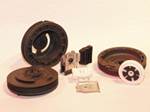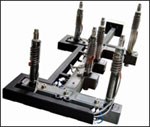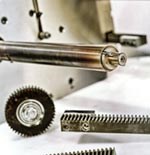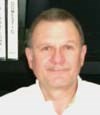Hot Stuff!
Advances in valve gating technologies and improved efficiencies heat up the hot runner market in 2005.
Just as moldmakers continually strive to produce the highest quality molds in the shortest leadtimes possible, hot runner manufacturers and suppliers are doing the same. This year—in addition to a number of new products in the hot runner market—these manufacturers/suppliers are working toward continuous improvements of their parts and systems. Trends include more efficiency, the emergence of valve gating, newly designed heaters and more customization in supplied systems. Here is what the major suppliers had to say about where the market is heading.
What major advancements to you foresee in hot runners this year? And how will these advancements affect the moldmaker, mold designer and the moldmaking process in general?
Patrick Bennett, vice president of sales and marketing, Mold-Masters Ltd. (Georgetown, ON): We see a growing shift toward valve gating in applications that have traditionally used tip gating such as packaging. Until recently, valve gating has been primarily used to ensure a pristine quality gate finish on the part. Moldmakers and molders alike are seeing valve gating as a solution to many of their part quality and processing challenges. The move toward valve gating creates opportunities for moldmakers to differentiate themselves by offering premium mold solutions to their customers. The hot tip side of gating has been an under-serviced area to date. Watch for some advancements here—especially for the medical market.
Moldmakers are placing three very clear business demands on their hot runner suppliers. "First, make it easy for me to specify, order and take delivery of my hot runner on-time. Second, the hot runner must integrate easily into my molds and third, I need off-the-shelf replacement parts delivered fast anywhere in the world." The global hot runner suppliers must be seeking ways to address all three of these demands in the coming months and years. Moldmakers today are operating in a very competitive market. They may need to switch to a hot runner supplier that offers them a solution to their need for convenience, integration and speed.
Brandon Brusca, sales/marketing, ALBA Enterprises, Inc. (Rancho Cucamonga, CA): We at ALBA/Thermoplay foresee hot runner efficiency becoming more important. Rising resin prices are forcing manufacturers to look for ways to save on material. Also, with energy costs rising in the world, manufacturers are forced to look for more efficient heaters. Many new engineered materials require almost perfect heat profiles, so this will be a major focus—especially in medical applications. With the technology of new analyzing equipment and processors, QA personnel are able to see the faults and flaws in a part to a more critical point. With the advancements of plastics in large automotive applications, large manifolds are being designed, and sequential valve gating is being utilized. Online information is needed by designers and moldmakers to receive immediate drawings and files for design and maintenance.
Bill Hume, president, Synventive North America (Peabody, MA): Faster hot runner system leadtimes and deliveries will continue to be of importance; providing custom systems to the moldmaker in a shorter amount of time. Custom is an important designator; as opposed to standard or off-the-shelf type hot runners. Moldmakers and end users are demanding customized systems in less time. Faster hot runner deliveries allow for faster mold design, reduces the need for concurrent engineering and cuts down on mistakes in the process. Overall improvements in technology include 3-D solid models of the system being transferred electronically to the moldmaker and more finite element analysis (FEA) being used in design to specify the performance of the hot runner system for its specific applications. All of these developments are improving the process for everyone, in a shorter amount of time.
In addition, another trend we are seeing is more requests for our hot runner systems supplied pre-wired with our WireGuard configuration (see photo on opposite page), or even complete hot halves—moldmakers prefer this as it makes their life easier.
Finally, we have also seen a need in the industry for higher technology from the hot runner supplier. For example, systems that include process control capability, beyond even what sequential valve gating can provide. Our Dynamic Feed hot runner technology, which was introduced in 2000, meets that need and continues to grow in popularity. It has independent flow control of filling and packing profiles at each nozzle gate, allowing for enhanced processing flexibility and ultimately, lower piece-part costs.
John Blundy, vice president of business development, Incoe Corp. (Troy, MI): Technology drives our industry, so as a component supplier we are compelled to strive for continuous improvement. As a hot runner supplier, these improvements can take place in design, processing, installation, manufacturing methods, and time-to-market. Certainly we have effort in all these areas.
Martin Baumann, sales and marketing manager, Hot Runners, Husky Injection Molding Systems (Milton, VT): From a global perspective, the most important advancement needs to be made in production leadtimes. Asia is putting tremendous pressure on North American and European hot runner sup-pliers. In order to compete, suppliers need to get their leadtimes down to the two- to four-week range. At Husky, our Pronto hot runners currently allow us to do this for configurable systems. We are in the process of transferring some of the pro-cesses we use in the Pronto program to our entire hot runner line.
Ken Kurtz, hot runner product manager, D-M-E Company (Madison Heights, MI): Quicker delivery times is an important issue to moldmakers and molders. They need to produce molds and parts quickly so products get to market quicker. Additionally, we see the need for molders to add more value to what they are doing. This is driven by offshore competition, and an emerging trend from this is the two-shot molding approach, which could be a hard substrate overmolded with a soft cover—depending on the application. This trend of two barrels on the machine will continue because it allows the molder to add value to the part. Along those lines, the molder can process two different materials or two different colors. The other option available with the two barrel approach is coinjection—in which the skin can be virgin material and the core resin can be regrind. Moldmakers will benefit by having more opportunities to build tools for these applications.
Higher productivity is another advancement, and high cavitation systems will address this need. D-M-E now has 96-drop Galaxy systems in production. Each Galaxy hot half system is fully assembled, wired, and electrically tested so the moldmaker is assured that the hot runner is ready for startup.
Six Sigma and lean manufacturing initiatives that are on the rise will drive hot runner system growth—especially in engineered resins. As lean teams look for ways to reduce costs, improve efficiencies and eliminate waste, we are well positioned to provide hot runner solutions to some of these challenges. The value of these advancements is more work for moldmakers too.
What developments are underway within your company specifically in regards to hot runners?
Bennett, Mold-Masters: We have recently launched the Accu-Valve, a premier valve gate solution. This cylindrical valve gating system delivers such precise pin alignment that it maintains pristine part quality through millions of shots.
One of the new products that was a real hit with our customers at the K-Fair was the Melt-Disk, which offers hot tip performance for many edge gate applications. This has already been proven on a number of pipette and syringe molds with their thin-walled, slender, cylindrical parts. We are working with a select group of key customers to roll this product out during 2005. It’s one of those really innovative products that people say, "That’s neat".
Usage of our online design tool, Merlin, has more than doubled in the past year and we see this growth accelerating as a new generation of moldmakers expects to have online access to their 3-D custom drawings and their order status. Merlin makes it easy to order systems and parts from anywhere at anytime.
Brusca, ALBA Enterprises: ALBA Thermoplay has been doing extensive testing and research, and has proven to build manifolds that are naturally balanced by design. This eliminates the problem of material getting trapped in corners and degrading, or cavities filling unevenly. We do this on a single level to eliminate excess material and residence in the manifold. The large manifolds use expansion joints to eliminate stacking of manifolds. The thermal expansion will grow the manifold joints to prevent leaking. This has been successfully used in large applications throughout Europe. Thermoplay’s sequential controllers are very precise, and can operate a valve multiple times per cycle.
The new F-series nozzles introduced at K2004 feature a new heater design that uses a blanket-style heater. The special heater design and selected materials reduce the coefficients of thermal expansion between the different metals. As heat is increased, the heater will tighten around the nozzle. This allows 30 percent better heat transfer and profiles—resulting in up to 60 percent energy savings. The special heater exit styles allow maintenance in the press. Nozzle diameters range from micro 11mm up to 70mm as standard and lengths up to 216mm standard. Thermoplay offers drawings online for designers to download. Hume, Synventive: A new program being introduced in early 2005 is the KONA X2 program, whereby all Synventive KONA XP custom hot runner systems will be available for delivery in two weeks. In 2004, Synventive introduced the four-week deliveries program. Now, further automation of the manufacturing process—combined with engineering efficiencies—has allowed the company to further reduce this delivery time to two weeks. In addition, several new hot runner nozzle products are being developed that will be introduced in 2005.
Blundy, Incoe: Naturally we have ongoing in-house research and development on our core products; examples are our integrated and unitized hot runner systems. Additionally, we also have formed alliances with other synergistic companies in the belief that no one has all of the answers. The combined technologies provide advantages for our customers. Those alliances are Beaumont Runner Technologies (providing melt rotation technology) and RJG Inc. (using their software for valve gate control operation). (See RJG’s Rigorous Mold Tryout: Do Your Homework article on page 62 of this issue.)
Baumann, Husky: With our new Shanghai Technical Center now in full production of hot runners for the Asian market, we now have a truly global hot runner network. This is important as many of our customers have locations around the world and need a hot runner supplier with global parts and service support. Our hot runner manufacturing facilities in Vermont, Luxembourg and China allow us to provide 24/7 assistance to our customers.
On the product side, Husky has optimized its UltraFlow melt mixing technology—allowing processors to use a wider range of resins while improving melt homogeneity and color dispersion. We’ve made some improvements to our previous design so that UltraFlow nozzles are now better suited for a wider range of resins, including engineering grades like ABS and PA with little to no pressure increase. This significantly expands application possibilities. The UltraFlow uses a static mixer to homogenize resin as it flows through the nozzle tip, significantly improving color change performance and reducing color change time for the majority of the resins used in injection molding. The new melt channel design also provides flowline-free parts and can help improve part quality and dimensional stability.
Also new from Husky is a wear-resistant Ultra Hot Tip designed for engineering-grade resins. It allows an improved processing window and superior gate quality for a wide range of applications. The new tip addresses problems that are associated with engineering-grade materials—narrow processing window, gate freeze-off and high wear. The Ultra Hot Tip’s steel insert provides increased wear resistance, while the composite retainer enhances the thermal profile of the tip. A wider processing window provides the molder with greater flexibility when molding difficult-to-process glass- or metallic-filled materials. The thermal properties of the new tip are also ideal for polyolefin applications, reducing the risk of stringing.
Husky also has unveiled a new line of hot runner temperature controllers. The new LEC line of temperature controllers provides molders with full-featured hot runner temperature control at an extremely competitive price. Designed for smaller hot runner system applications, the LEC is offered with two-, six- and 12-zone enclosures. An optional network module allows users to link two six- or 12-zone enclosures together for up to 24 zones of control. The network module also enables a link to plant monitoring systems. Flexibility has been built-in to the LEC line for global use. It is designed to work with most hot runner molds operating in the world today. We see the LEC as a true breakthrough in hot runner controller performance and affordability.
Kurtz, D-M-E: D-M-E recently intro-duced Stellar quick delivery systems, which tie into the need for quicker delivery times. We offer four-, eight- and 16-drop multi-nozzle assemblies (MNAs) configured to order in three to five days. The other two options are hot half systems, again with the platform four-, eight- and 16 drops in standard mold base sizes. We can deliver hot halves in five or 10 days—depending on the nozzle plate thickness required.
Our MPL (multi-parting line) systems address higher productivity with increased output. These hot runners are for stack molds or a dual mold carrier for two single parting line molds back to back. We are teaming up with our parent company Milacron to offer this technology as a turnkey solution and D-M-E is providing the melt delivery systems. These are cost effective ways to expand molding capacity without additional presses.
Clearly hot runner manufacturers and suppliers are in tune with meeting the needs of moldmakers and molders alike. Speed, efficiency and quality are the common buzzwords as these providers continue to strive to assist their customers in producing molds and parts as quickly as possible by supplying hot runner systems, parts and services in a timely and efficient manner.
Seeking Answers
Hot runner manufacturers and suppliers reveal the most common questions moldmakers ask about hot runner technology—and the answers they are given.
Bennett, Mold-Masters: "When can I have my drawings?" is a question we hear from moldmakers in the earliest discussions about a new project. Fortunately, Mold-Masters is well equipped to deliver final 3-D drawings quickly. We have invested in a sophisticated system called MasterSPEED that automates the creation of custom drawings within a few hours of placing your orders online.
Brusca, ALBA Enterprises: Gate vestige, processing and design assistance. For gate vestage, designers want to know how clean the shear point will be when the part ejects. It is very critical in medical, and cosmetic applications. Some hot runners can leave a large, sharp point where the part separates from the sub runner, or nozzle. With processing, molders want to know how easy the system is to start up. How consistent will filling be? Also, how much control do we have over the heat of the nozzles and manifold. Will there be any leaking prior to thermal expansion? Also, ease of maintenance. Regarding design assistance, mold designers need assistance selecting the correct nozzle or gating configuration. They need to know that we have support available any time they need it.
Hume, Synventive: One of the most commonly asked questions is, "Who takes responsibility for the hot runner system’s performance?" In Synventive’s case, we take responsibility. The hot runner is the enabling technology that ultimately is responsible for the finished part quality. We take the lead to make sure everything comes together to provide the highest quality part. Working closely with the moldmaker, mold designer, end user and material supplier is critical.
Blundy, Incoe: I believe we could summarize them all in the statement, "What can you provide to my company that helps me to be competitive in the global marketplace?" This reaches beyond the typical lower price, shorter delivery, questions.
Baumann, Husky: Besides leadtime and price, moldmakers in North America are asking about technology and development support that can help them compete. Advancing mold technology requires a high-performance hot runner system and applications such as multimaterial molding or stack molding. This, in turn, requires a very close working relationship between the moldmaker and the hot runner supplier. We have seen an increase in joint development programs to achieve specific performance criteria in a variety of areas—including cycle time reduction, improved gate vestige and special materials.
Kurtz, D-M-E: The two top questions we receive are how fast can you service my system and how fast can you deliver a system? To address service, our hot runner service center has emergency service available and can work around the clock to do any repairs on any hot runner system—provided we can get the parts. Other services include refurbishing and cleaning. For fastest possible delivery, our answer is to set the moldmaker up with one of our quick delivery systems.
We also field many questions on specific applications: How many gates do you recommend, what are the best locations for the gates, and what are the gate diameters you recommend? Moldmakers can optimize the mold design when these questions are answered. To best answer these questions, D-M-E can provide a Moldflow analysis, which is a finite element technique that simulates the processing conditions and eliminates the trial and error method.
Related Content
Solving Mold Alignment Problems with the Right Alignment Lock
Correct alignment lock selection can reduce maintenance costs and molding downtime, as well as increase part quality over the mold’s entire life.
Read MoreFundamentals of Designing the Optimal Cooling System
The right mold components can help improve mold cooling and thereby produce higher-quality parts.
Read MoreTreatment and Disposal of Used Metalworking Fluids
With greater emphasis on fluid longevity and fluid recycling, it is important to remember that water-based metalworking fluids are “consumable” and have a finite life.
Read MoreLaser Welding Versus Micro Welding
The latest battle in finely detailed restoration/repair of mold materials.
Read MoreRead Next
Benefiting From Hot Runner Design and Reliability
Selecting a hot runner system designed with the moldmaker and end user in mind has helped a moldmaking shop remain competitive.
Read MoreHow to Use Strategic Planning Tools, Data to Manage the Human Side of Business
Q&A with Marion Wells, MMT EAB member and founder of Human Asset Management.
Read MoreReasons to Use Fiber Lasers for Mold Cleaning
Fiber lasers offer a simplicity, speed, control and portability, minimizing mold cleaning risks.
Read More




















.jpg;maxWidth=300;quality=90)







